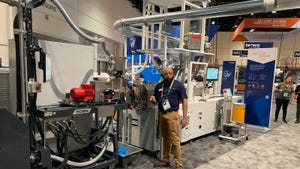Chemical recycling closes the LOOPLA for cradle-to-cradle PLA
Plastics processors understand well that plastics, whether petroleum-based or bio-based, are valuable materials for which a host of end-of-life options have been developed. Re-use and recycling routes are in place for petroleum-based polymers such as PET, PE, PVC and EPS, with energy recovery through combustion serving as the ultimate solution.
September 26, 2011
Non-degradable biobased materials currently also are incinerated, as robust recycling options are lacking for these plastics. However, it was long thought that the best way to dispose of bio-based, degradable plastics - polylactic acid (PLA) being a good example - was to allow them to degrade in the environment, thus avoiding the waste and pollution problems associated with conventional polymers. Gradually, however, it is starting to be recognized that disposing of all biodegradable polymers through industrial composting is by no means always the most efficient end-of-life choice. New options are now slowly appearing.
Galactic, a Belgian company specialized in the production of lactates and lactic acid mainly from sugar beets, is among those researching better avenues for the disposal of post-consumer PLA plastic waste. The company has a vested interest in the disposal issues surrounding PLA: in 2007, together with Total Petrochemicals, it established a joint venture called Futerro that aimed to develop a clean and competitive technology for the production of PLA. The lactic acid is sourced from Galactic, while the polymerization technology required is contributed by Total Petrochemicals. Today, Futerro produces a family of second-generation PLAs for applications ranging from disposables and packaging to carpeting and electronics.
The problem: how to manage the PLA waste streams that were subsequently being generated? Not all types were biodegradable, due to the additive packages used to modify the properties of the material for different applications. And in the existing plastics recycling streams, PLA is seen as a contaminant, which leaves incineration as the sole remaining end-of-life option.
According to Steve Dejonghe, project manager at Galactic, it makes no sense to biodegrade or incinerate PLA waste. He explains:" Why should the value of a bioplastic like PLA go to waste, when it is perfectly possible to recycle it? At Galactic, we were looking for an economically viable recycling solution, and have now developed a process called LOOPLA, which is based on feedstock, or chemical recycling of PLA back into lactic acid."
The LOOPLA process is a robust one, allowing an almost 100% recovery of the PLA content and discarding all typical contaminants such as sand, dirt and dust. Waste PLA, both post-industrial and post-consumer, is shredded, after which it is moved into a reactor and converted, with the help of a solvent, back into lactic acid. Notes Dejonghe, "The recycling process is virtually endless, as the solvent can be used again and again. The quality of the lactic acid is just as good as the original, and can be used to make virgin-quality PLA."
Galactic has built an industrial-scale pilot plant in Belgium with a capacity of 2000 tons per year. The company is currently investigating ways to set up PLA waste collection systems and has entered into contracts to collect used PLA cups and bottles after big events. It is also exploring the possibilities of contracting with large-volume PLA-packaging users to develop a truly closed-loop solution. We'll keep you posted on further developments.
About the Author(s)
You May Also Like

